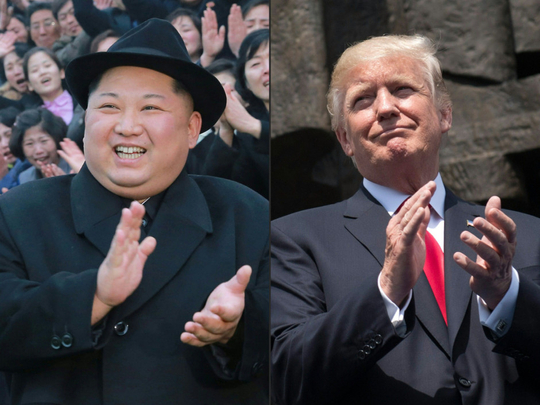
Now that the shock of United States President Donald Trump’s decision to meet North Korean dictator Kim Jong-un in May has worn off, it’s time to consider the broader strategic implications of how the US can best approach Kim’s lethal regime in particular, and Asia in general.
Let’s start with the tactical: Trump’s remarkable gamble of essentially “taking a meeting” with Kim — seemingly without any prior planning or even developing a basic agenda — is a fascinating new twist on traditional diplomacy. It will certainly capture headlines (and take a few away from Trump’s alleged paramour Stormy Daniels), but will it really change anything? Doubtful. To reverse the old clich of “it’ll get worse before it gets better”, the likelihood is that this one will get better before it gets worse (again). The fundamentals are bad, to say the least.
The likelihood of Kim ever giving up his nuclear weapons approaches negative infinity. After all, the reason he is willing to slow his programme and come to a meeting with Trump is not the president’s “fire and fury” rhetoric — it is the simple fact that he and his scientists have worked hard, spent an enormous amount of his country’s limited resources, and built a boutique nuclear capability with demonstrable reach. That makes him, like Pinocchio, a “real boy” in the world of nuclear powers. He will never give that up, especially having watched others like former Iraq president Saddam Hussain and former Libyan dictator Muammar Gaddafi topple after walking away from their “weapons of mass destruction”.
Kim’s so-called peace offensive is the result of three things: The enormous cost of this programme relative to his nation’s economy; how swiftly he has advanced his nuclear programme’s technology; and China’s willingness to actually enforce some United Nations sanctions that have been largely ignored until a few months ago. The Olympics in South Korea provided a convenient moment for him to dispatch his sister Kim Yo-jong — the “Princess of Pyongyang” — to trot out the best-known manoeuvre in the North Korean playbook: Come to the table, get everyone excited about “peace in our time”, demand and receive concessions, and revert to bad behaviour.
Still, with all these caveats, we should still open talks with North Korea. Anything is possible, especially in a dystopian and unpredictable (but not irrational) regime like North Korea. So let’s have a conversation, hopefully with a well-briefed, historically grounded negotiating team backing up America’s highly mercurial president. Tactically, there is little to lose. But more importantly, let’s take a strategic look at how to play the hand of cards.
While the US certainly ought to be mindful of North Korea’s growing nuclear capability and intercontinental ballistic missiles, they are in the end a highly tactical and isolated concern. Instead of putting North Korea at the centre of America’s Asian agenda, we should step back and consider what America’s real interests are in the region. North Korea is not the centrepiece of America’s Asia-Pacific strategy.
So what really matters?
First and most important are America’s relationships with key allies, partners and friends. These range from treaty allies whom Washington is sworn to defend — Japan, South Korea, Australia, New Zealand, the Philippines and Thailand — to nations with whom it shares very close political, economic and defence relationships. The latter include Singapore and Malaysia, and now increasingly India, Vietnam and Indonesia. America’s most vital interest is ensuring that it maintains its principle advantage over China and Russia: That network of close partners.
Second, America should recognise that the relationship that truly matters in Asia is that between the two dominant Pacific powers: China and the US. America needs a coherent, thoughtful, long-term strategic approach for dealing with China that encompasses — but is not dominated by — the North Korean issue. This means listening to America’s partners (especially Japan); playing the long game against Chinese demands for territorial control of the South China Sea; pushing back on Chinese cyber-forays; and maintaining a qualitative military edge over Beijing.
Third, in terms of talks, America needs to think bigger than just the US and North Korea. Washington should look to expand the South Korean-North Korean dialogue from a two-party conversation to a legitimate four-party engagement: Bringing both the US and China to the table. Only by providing security guarantees to both sides of the Demilitarised Zone can we hope to move forward. And over the longer term, getting Japan into the conversation — and also perhaps Russia, a legitimate Pacific power — may make sense. Six-party talks can cover a vastly greater range of issues.
While we’re at it, one hopes the Trump administration will take another look at the idea of the Trans-Pacific Partnership, the trade agreement between a dozen Pacific countries who are moving forward despite the US withdrawal from the accord.
In terms of the May meeting between Trump and Kim, we should hope that it follows the fundamental dictate of the Hippocratic Oath: “Do no harm.” While a summit may prove momentarily satisfying, it is essentially a sugar high. A more lasting prescription would be to take a strategic approach, listen intently to America’s regional allies (especially Japan), incorporate China into the conversation now, and make sure Kim Jong-un knows he is not the centrepiece of the show. That’s what really matters in Asia today.
— Bloomberg
James Stavridis is a retired US Navy admiral and former military commander of Nato, and dean of the Fletcher School of Law and Diplomacy at Tufts University. His most recent book is Sea Power: The History and Geopolitics of the World’s Oceans.








